The Economics and Statistics Division maintains archives of previous publications for accountability purposes, but makes no updates to keep these documents current with the latest data revisions from Statistics Canada. As a result, information in older documents may not be accurate. Please exercise caution when referring to older documents. For the latest information and historical data, please contact the individual listed to the right.
<--- Return to Archive
For additional information relating to this article, please contact:
June 19, 2019NOVA SCOTIA QUARTERLY POPULATION ESTIMATES AS OF APRIL 1, 2019 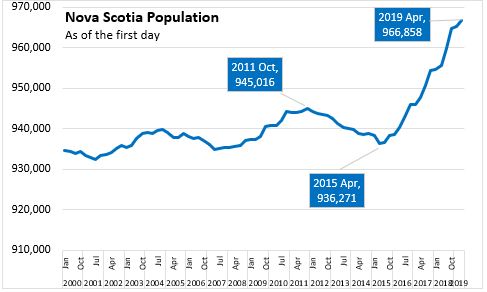
Nova Scotia’s population increased by 1,476 between January 1 and March 31, 2019. The population as of April 1, 2019 was 966,858, the highest population for Nova Scotia on record. Since April 1, 2015 Nova Scotia's population has increased by 30,587. This quarter's increase reflects an increase in immigrants, net non-permanent residents and net interprovincial migration offsetting the natural population change.

There are seasonal patterns in quarterly population changes, particularly evident in births and international migration. In the last four years, the first quarter has shown stronger population growth than previous years. Population growth of a similar magnitude as the last four years has not been seen in the first quarter of a year since 1985.
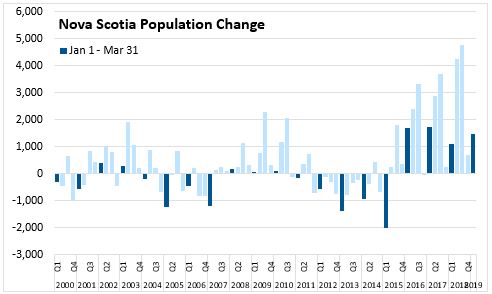
Population growth in Nova Scotia is typically slower than the national average pace. In the last quarter, Nova Scotia’s population increased by 0.15 per cent compared to the January 1 estimate. The national population grew by 0.26 per cent over this period. Compared with April 1, 2018 Nova Scotia’s population has increased by 1.17 per cent, or 11,150, while the national population grew by 1.42 per cent.
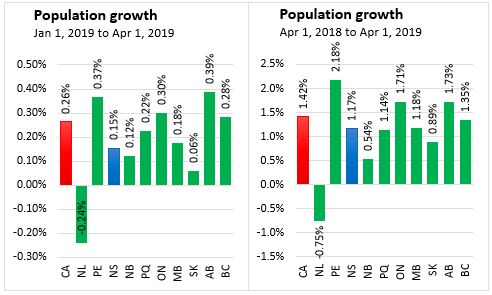
In recent years, immigration from other countries has been a strong contributor to population growth in Nova Scotia. Nova Scotia received 1,271 immigrants during the first quarter of 2019. Quarterly immigration continues to be higher than historical averages.
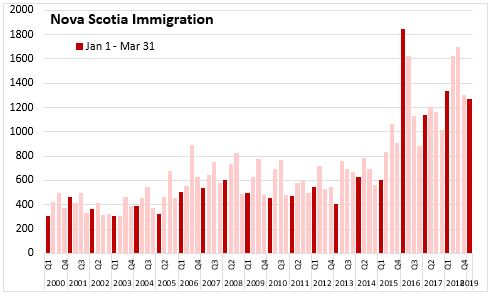
Net non-permanent residents can be a key component of quarterly demographic growth. In this quarter, Nova Scotia saw a net gain of 601 non-permanent residents since January 1, 2019. This is the second strongest inflow, after Q1 2016, for the first quarter on record since 1972.
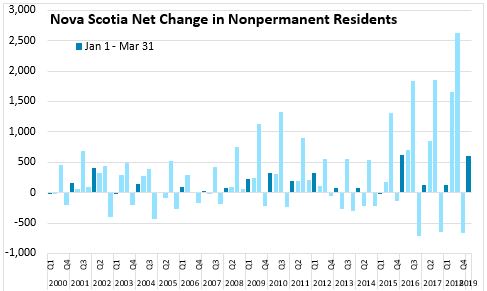
Nova Scotia’s natural population change (the number of births, less the number of deaths) has been negative for several years. Between January 1, 2019 and March 31, 2019, there were 2,065 births and 2,504 deaths, amounting to a natural population decline of 439.
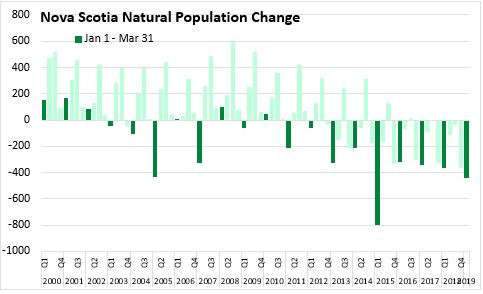
Interprovincial migration has historically shown a net outflow of Nova Scotia's population to other provinces. Recent quarters have shown population growth through interprovincial movements. This quarter, Nova Scotia had a net inflow interprovincially of 221 persons, with net inflows from six provinces.
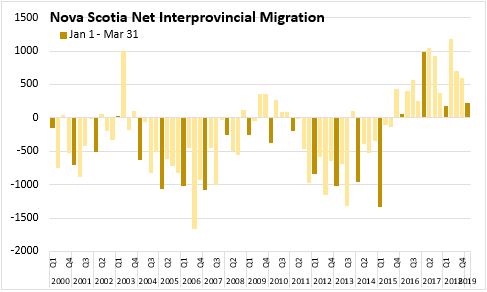
Out-migration from Nova Scotia to other provinces decreased compared to the first quarter of 2018. Out-migration declined to Ontario, Newfoundland and Labrador, Quebec, Manitoba, Saskatchewan and British Columbia. Out-migration to New Brunswick, Alberta, and Prince Edward Island increased compared to Q1 2018. Out-migration to Alberta remains below levels seen in the 2010-2015 period.
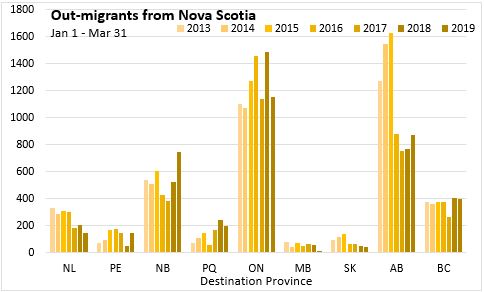
For Q1 2019, in-migrants to Nova Scotia increased from British Columbia, Prince Edward Island, Newfoundland and Labrador, Alberta, and to a lesser extent from Saskatchewan and Manitoba. For the first quarter, in-migrants from Ontario have declined in recent years, while they have been trending upwards for Newfoundland, New Brunswick, and British Columbia.
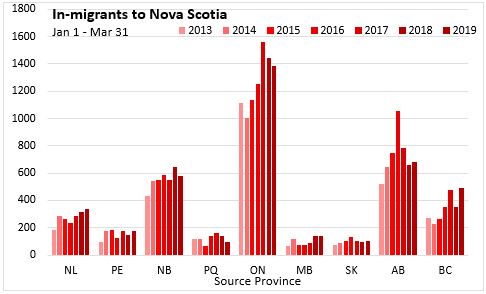
Interprovincial migration to Nova Scotia was a net inflow of 221 persons in Q1 2019. Outflows to Ontario and British Columbia in the first quarter of 2018 have turned to inflows, while the net inflow from New Brunswick has become an outflow in the first quarter of 2019. Net inflows from Newfoundland and Labrador and Manitoba have become stronger in recent years.

Source: Statistics Canada.
Table 17-10-0009-01 Population estimates, quarterly
Table 17-10-0020-01 Estimates of the components of interprovincial migration, quarterly
Table 17-10-0040-01 Estimates of the components of international migration, quarterly
Table 17-10-0045-01 Estimates of interprovincial migrants by province or territory of origin and destination, quarterly
Table 17-10-0059-01 Estimates of the components of natural increase, quarterly
<--- Return to Archive